Summary of Findings
What’s Your News IQ? Take the Latest Quiz
Since the late 1980s, the emergence of 24-hour cable news as a dominant news source and the explosive growth of the internet have led to major changes in the American public’s news habits. But a new nationwide survey finds that the coaxial and digital revolutions and attendant changes in news audience behaviors have had little impact on how much Americans know about national and international affairs.
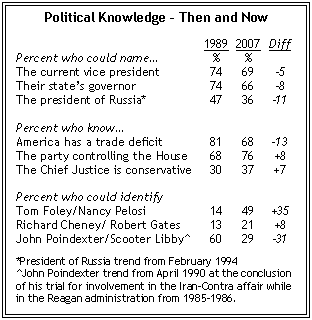
On average, today’s citizens are about as able to name their leaders, and are about as aware of major news events, as was the public nearly 20 years ago. The new survey includes nine questions that are either identical or roughly comparable to questions asked in the late 1980s and early 1990s. In 2007, somewhat fewer were able to name their governor, the vice president, and the president of Russia, but more respondents than in the earlier era gave correct answers to questions pertaining to national politics.
In 1989, for example, 74% could come up with Dan Quayle’s name when asked who the vice president is. Today, somewhat fewer (69%) are able to recall Dick Cheney. However, more Americans now know that the chief justice of the Supreme Court is generally considered a conservative and that Democrats control Congress than knew these things in 1989. Some of the largest knowledge differences between the two time periods may reflect differences in the amount of press coverage of a particular issue or public figure at the time the surveys were taken. But taken as a whole the findings suggest little change in overall levels of public knowledge.
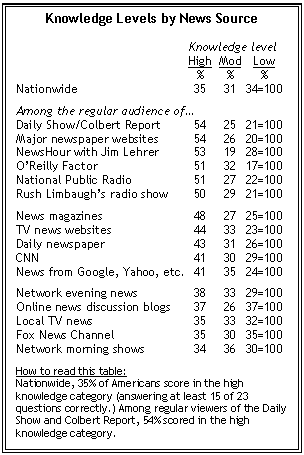
The survey provides further evidence that changing news formats are not having a great deal of impact on how much the public knows about national and international affairs. The polling does find the expected correlation between how much citizens know and how avidly they watch, read, or listen to news reports. The most knowledgeable third of the public is four times more likely than the least knowledgeable third to say they enjoy keeping up with the news “a lot.”
There are substantial differences in the knowledge levels of the audiences for different news outlets. However, there is no clear connection between news formats and what audiences know. Well-informed audiences come from cable (Daily Show/Colbert Report, O’Reilly Factor), the internet (especially major newspaper websites), broadcast TV (NewsHour with Jim Lehrer) and radio (NPR, Rush Limbaugh’s program). The less informed audiences also frequent a mix of formats: broadcast television (network morning news shows, local news), cable (Fox News Channel), and the internet (online blogs where people discuss news events).
Aside from news media use, demographic characteristics, especially education, continue to be strongly associated with how much Americans know about the larger world. However, despite the fact that education levels have risen dramatically over the past 20 years, public knowledge has not increased accordingly.
These are the principal findings of an in-depth Pew Research Center survey that interviewed a representative national sample of 1,502 adults between Feb.1-13, 2007. Respondents were asked to identify public figures who had recently been in the news. They also were asked questions that measured how much they knew about important and widely covered news events. Awareness of public figures varied widely.
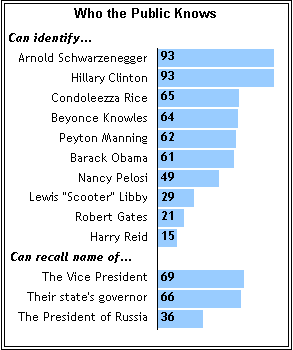
More than nine-in-ten Americans (93%) could identify Arnold Schwarzenegger as the California governor or a former action-movie star – both responses were counted as correct in the scoring. An equally large proportion of the public identified Hillary Clinton as a U.S. senator, a former first lady, a Democratic leader, or a candidate for president. Clear majorities can also correctly identify Secretary of State Condoleezza Rice (65%) and Sen. Barack Obama (61%). House Speaker Nancy Pelosi is recognized by about half of the public (49%).
Other prominent national figures and world leaders are not as well known. When asked to name the president of Russia, just 36% recalled Vladimir Putin. Only about three-in-ten (29%) could correctly identify former White House aide Scooter Libby; the survey was conducted during Libby’s trial – but before his conviction – on perjury and obstruction of justice charges.
Public knowledge of news events also varies widely. Nearly nine-in-ten (88%) knew that as part of his revised Iraq strategy, President Bush planned to increase U.S. military forces in the country. But only one-in-four Americans (24%) are aware that both houses of Congress passed legislation to increase the minimum wage and 34% knew that Congress voted to raise the minimum wage to $7.25 an hour.
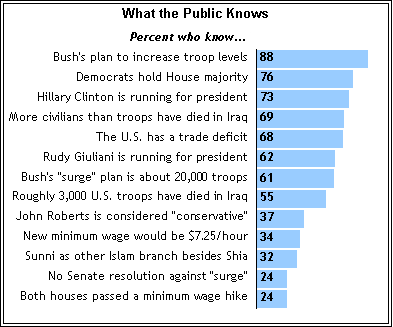
Distinct patterns emerge when these results are analyzed by key demographic groups. Education proves to be the single best predictor of knowledge. Holding all other factors equal, levels of knowledge rise with each additional year of formal schooling. At the extremes, these educational differences are dramatic: People with postgraduate degrees answer, on average, about 17 of the 23 questions correctly, while those who did not finish high school average only about eight correct answers.
Other demographic differences are also striking. Men, on average, knew more than women, all other factors being equal. Older Americans – particularly those 50 years old or older – did better than younger people. Whites scored better than blacks, while more affluent Americans knew more than those with lower household incomes.
As part of the Pew Knowledge Project, people are invited to test their own news IQ by taking an interactive knowledge quiz now available on the Pew Research Center website. The short quiz includes versions of the some of the same questions that were included in the national poll. Participants will instantly learn how they did on the quiz in comparison with the general public as well as with people like them. Take the quiz.
Grading the Public

To measure overall knowledge levels, a core group of 23 of the 26 questions was used to form a knowledge index. Each correct answer counted as one point, producing a scale that ranges from zero – no correct answers – to 23, a perfect score. Each respondent received a score based on the number of questions he or she answered correctly.1
Eight people out of the 1,502 respondents answered all 23 questions correctly. At the other end of the spectrum, five people failed to answer a single question correctly. The average respondent got about 12 of the 23 questions right, or slightly more than half. 10 percent answered 20 or more questions accurately – and 5% got more than 20 questions wrong or said they did not know the answer.
Using a common school grading scale in which 90% correct is the minimum necessary to receive an A, 80% for a B, 70% for a C, 60% for a D and less than 60% is a failing grade, Americans did not fare too well. Fully half would have failed, while only about one-in-six would have earned an A or B. While such a scale is useful in the classroom, it may be a poor way to judge whether people are sufficiently informed. Opinions vary about what people “should” know about news events, and a different mix o f questions could easily have produced very different results.
In fact, an experiment conducted in conjunction with this survey suggests that when people are given a “multiple-choice” version of key questions, the proportion who selected the correct response increased, sometimes dramatically.
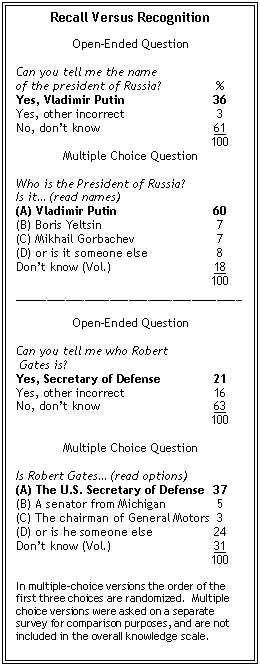
For example, only 36% were able to volunteer Putin’s name when asked in the February poll, “Who is the president of Russia?” But 60% correctly selected Putin when the question was asked this way in the test survey: “Can you tell me who is the president of Russia? Is it Boris Yeltsin, Vladimir Putin, Mikhail Gorbachev, or is it someone else?” Similarly, only 21% correctly answered that Robert Gates is the secretary of defense in the February survey, compared with 37% who did so when asked to choose whether Gates was the defense secretary, a senator from Michigan, the chairman of General Motors or held another job.
On other questions, the differences attributable to alternative formats were less dramatic. About three-in-four (76%) were able to volunteer unaided that the Democrats controlled the House of Representatives. When on the test respondents were asked which political party controlled the House, followed by the prompt: “Is it the Democratic Party or the Republican Party,” 82% answered correctly, a six-percentage point increase.
The results do not suggest possible explanations for the differences. Some of the gap may be explained by lucky guessing on the part of people who heard the correct choice along with some incorrect alternatives. Or perhaps asking people to volunteer an answer causes some to grow anxious and momentarily forget the right answer, or simply to say they do not know in order to hurry the interview along.
Demographic Differences in What Americans Know
To compare knowledge levels between demographic groups, the sample was divided into roughly equal thirds on the basis of how many of the 23 questions they answered correctly. About 35% of the sample answered 15 or more correct out of 23 core questions. For purposes of this analysis, they were classified as the “High” knowledge group. About 31% answered 10 to 14 questions correctly, and they were classified as having “Medium” levels of knowledge. Those who got nine or fewer questions right were assigned to the “Low” knowledge group.
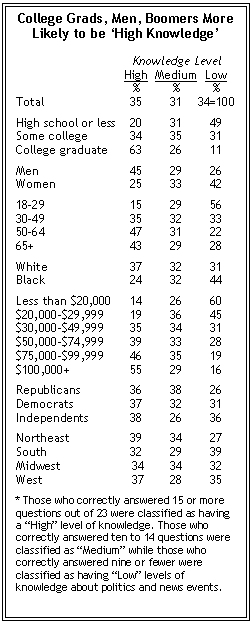
Using this yardstick, differences in knowledge levels among core demographic groups stand out in sharp relief. More than six-in-ten college graduates (63%) fall into the high knowledge group, compared with 20% of those with a high school education or less – among the largest disparities observed in the survey. At the other end of the scale, half of those who had no more than a high school diploma (49%) are in the low knowledge group while only about one-in-ten college graduates (11%) fare as poorly.
Traditionally, men are more likely than women to say they closely follow politics and international affairs, and the results of the knowledge survey appear to reflect this divide. Nearly half of all men (45%) score in the top third, compared with 25% of women. Among those at the bottom third of the scale, women (42%) outnumber men (26%). Whites are more likely to be represented in the top group, while a larger proportion of blacks than whites (44% vs. 31%) fall into the low-knowledge group.
Dramatic differences emerge when the results are broken down by age. Young people know the least: Only 15% percent of 18-29 year-olds are among the most informed third of the public, compared with 43% of those ages 65 and older. But it is not these oldest respondents who know the most. Instead, it is people in the age group younger than them – those ages 50-64 – who are slightly more likely to finish among the third of the sample who know the most (47% vs. 43%) and less likely to be represented among those who know the least (22% vs. 28%). This difference likely is caused by the very different life circumstances of the two oldest age groups. Many of those 65 and older are retired from work, and health problems as well as lifestyle changes can disproportionately work to diminish the interest or ability of some in this generation to keep up with the news.
More affluent Americans also are disproportionately represented in the high-knowledge group, a difference that held even after level of schooling, age, gender and race were taken into consideration in the analysis. A clear majority (55%) of those with household incomes of $100,000 or more are among the third of the sample that knew the most, compared with just 14% of those with household incomes of $20,000 or less.
Republicans and Democrats are equally likely to be represented in the high-knowledge group. But significantly fewer Republicans (26%) than Democrats (31%) fall into the third of the public that knows the least.
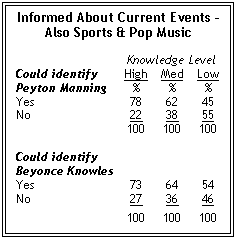
The survey also suggests that people who know more about politics and world events also tend to correctly identify popular celebrities. For example, nearly eight-in-ten respondents (78%) in the high-knowledge group could identify football star Peyton Manning, compared with 45% of those in the low-knowledge group. Similarly, those conversant with politics and world affairs also are more likely to correctly describe singer and actress Beyonce Knowles. While based on only two questions, these finding do suggest that more informed people may know a bit about a wide variety of subjects, including pop culture.
Knowledge Domains
Knowledgeable people tend to know things about both politics and foreign affairs while less informed Americans tended to know little about either subject, the survey found. For example, nine-in-ten of those who could name Vladimir Putin as the president of Russia also could identify Barack Obama. Similarly, nine-in-10 of those who didn’t know the Illinois senator also couldn’t correctly name the Russian leader.
Some demographic groups also did comparatively better on questions that broadly resonated with group members. For example, the survey found that blacks generally lagged behind whites in terms of their overall political knowledge. But African Americans had no trouble recognizing either Rice or Obama: 70% of all blacks and 66% of whites could identify Rice, and both races did about equally well identifying the Illinois senator. Other results suggest that women were somewhat more likely to know more about domestic politics than they did about international affairs, while men were more likely to know about as much on both subjects.
But overall, there was a close correlation between what people knew about domestic politics and foreign affairs. Only a handful of Americans – less than 3% of the total sample – were “knowledge specialists” who knew a lot about one subject but comparatively little about the other.
Knowledge and Political Engagement
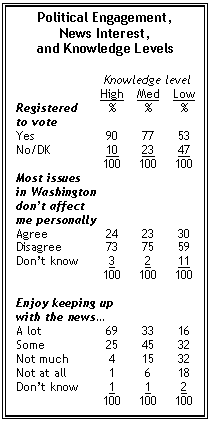
More informed Americans enjoy keeping up with the news, believe they have a personal stake in what goes on in Washington, and are significantly more likely to be registered to vote than people who know less, the survey found.
Among those in the third of the sample who know the most, the overwhelming majority (90%) are registered to vote compared with about half (53%) of the least knowledgeable Americans. The knowledgeable public also is more likely to see issues debated in Washington as having a direct impact on their lives (73% vs. 59%).
Rather than being a burden, the survey suggests these informed Americans like keeping up with what’s going on in the news. About seven-in-ten (69%) in the high-knowledge group say they enjoy keepin g up with the news “a lot,” compared with only 16% of the least informed.
Political Knowledge Over Time
The public’s ability to recall the names of leading political figures has not changed substantially since 1989. In the current survey, 69% correctly named Dick Cheney as the vice president. In May 1989, slightly more (74%) were able to name Dan Quayle as vice president. Somewhat fewer people could name their state’s governor now than did so in 1989, but again the differences are not dramatic (66% now, 74% then).

In terms of knowledge of politics and current events, significantly fewer people now know that the U.S. buys more goods from abroad than it sells than did so in 1989 (68% now vs. 81% then). But the political climate for this issue also has changed considerably. During the late 1980s, the U.S. trade deficit – especially trade tensions with Japan – drew much greater attention from the press and politicians than they do today.
On the other hand, there are subjects about which the public is better informed now than it was in 1989. Roughly three-quarters of Americans (76%) know that the Democrats have a majority in the House of Representatives, compared with 68% in 1989. The extensive press coverage of both the Democrats’ victory last fall and the new Congress may be factors in the relatively high level of public awareness of this fact. In June 1995, a few months after Republicans won control of Congress, 73% knew that the GOP had a majority in the House – the second-highest percentage correctly answering this question since 1989.
In addition, 37% know that Chief Justice John Roberts is generally considered a conservative, rather than a moderate or liberal. Somewhat fewer were aware of former Chief Justice William Rehnquist’s ideological background in 1989; 30% knew he was a conservative. In both cases, however, substantial numbers were unable to offer a response about the chief justice’s ideology – 50% in 1989, 48% currently.
Differences in news environment also are apparent in other comparisons. In early February, 29% of the public could correctly identify Lewis “Scooter” Libby, who was then facing trial for lying to federal investigators probing the unauthorized release of CIA agent Valerie Plame’s name to the news media. In April, 1990, 60% of the public could identify former White House aide John Poindexter, who was then on trial for his involvement in the Iran-contra scandal, a much higher-profile, longer running and widely covered investigation than the Plame leak probe.
But a deeper analysis of the five identical questions asked in both 1989 and 2007 reveals a surprising pattern: Americans didn’t do as well in 2007 compared with how similarly-educated Americans performed in 1989. Across the board, scores declined significantly among college graduates, those with some college as well as for those with a high school education or less.

For example, 74% of those with college degrees answered at least four questions correctly this year, compared with 80% in 1989. A similar pattern emerged among those who had attended college for at least a year but did not graduate: 51% in 2007 but 59% in 1989 got at least four questions right. Among those with no more than a high school diploma, the proportion getting four or five answers right declined 11 percentage points to 30%.
What keeps the overall knowledge scores from declining is that college grads still know more than less well-educated Americans – even if they know less in absolute terms than college grads in the past – and there are proportionally more of them now than there were 18 years ago. Currently about 27% of the public are college graduates, compared with 17% in 1989. At the same time, there are fewer people who have only a high school education (50% now compared with 60% in 1989). Education still leads to increased knowledge about prominent people and events in the news – but it does not confer as much of an advantage now as it did in 1989.
News and Knowledge

People inevitably must learn most of what they know about current events and political figures from the news media, since few have any direct way to obtain this information. Not surprisingly, people who say they regularly watch, read, or listen to the news know more than those who don’t. And people who use more news sources know more than those who use fewer sources. The differences are dramatic. Nearly three quarters (73%) of those who say they don’t get news regularly from any news source fell into the low knowledge group – correctly answering an average of only six out of the 23 questions in the quiz. By contrast, about half of those who regularly use at least seven sources score in the high knowledge group – getting an average of 18 questions correct.
The poll’s respondents were asked if they regularly watched, read, or listened to each of 16 different sources.2 Nearly everyone (94%) said they regularly get news from at least one of the news sources listed, and the average number of sources regularly used was between four and five (4.6). The audience size ranged widely. Local media garnered the largest regular audiences, with majorities reporting that they regularly watched local television news (71%) and read a daily newspaper (54%). Other television sources were also popular, with somewhat fewer than half watching network evening news (46%), the Fox News Channel (43%), and CNN (39%). About one third of respondents (34%) said they regularly watched the major network morning news shows.
Three more specialized television sources attracted smaller audiences. Fewer than one-in-five said they regularly watch “The O’Reilly Factor” with Bill O’Reilly (17%), comedy news shows like the Daily Show and the Colbert Report (16%), or the NewsHour with Jim Lehrer (14%).
Nearly four-in-ten people (37%) regularly use at least one type of internet news source, either the news pages of major search engines such as Google or Yahoo (25%), the websites of the television news organizations (22%), or the websites of major national newspapers such as the New York Times or USA Today (12%). Additionally, about one-in-ten (11%) read online blogs where people discuss events in the news.
Two radio sources were included in the list: 28% said they regularly listen to news from National Public Radio, and 8% are regular listeners to Rush Limbaugh’s radio show.
Profile of Audiences
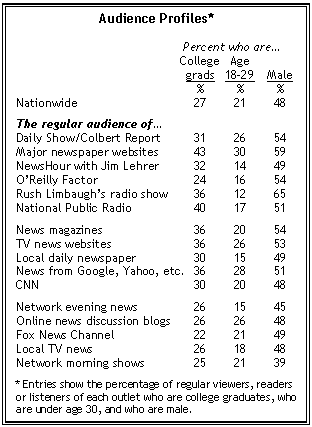
But not all news sources are created equal. The audiences for different sources vary greatly in how much they know about what’s going on, a consequence both of the kinds of people who rely on each type of medium and how much they may learn from specific sources.
Internet news sources, National Public Radio, news magazines, and Rush Limbaugh’s radio show have the best educated audiences, with each of these having at least 36% of their regular readers and listeners having graduated from college. The internet sources along with the comedy news shows attract younger-than-average audiences, though many older Americans regularly get news from these sources as well. The audience for the morning network news shows is disproportionately female (61%), while Limbaugh’s audience is heavily male (65%). A greater than average number of men are found in the audiences for the major newspaper websites (59%), for comedy news, The O’Reilly Factor, news magazines (54% each), and the TV news websites (53% male).
Conservatives and Republicans are especially attracted to Limbaugh, while more Democrats are found among the audiences for the NewsHour, the comedy new s shows, news magazines, and the websites of major newspapers.
Which Audiences Know the Most?
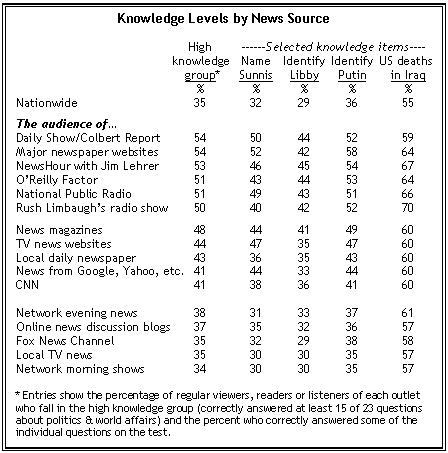
Attention to the news is strongly associated with knowledge levels, but some news audiences know considerably more than others. Overall, 35% of the public was classified as having a high level of knowledge – on average, 18 correct answers out of the 23 total questions. Half or more of the audiences for six media sources scored this high: the comedy news shows and major newspaper websites (54% in the high knowledge group), the NewsHour (53%), National Public Radio (51%) and Rush Limbaugh’s radio show (50%). Regular readers of news magazines were not far behind (48%).
By contrast, the regular audiences for many other sources scored no higher than the sample average. The audiences for morning news (34% high knowledge), local TV news (35%), Fox News Channel (35%), blogs (37%), and the network evening news (38%) were not significantly different from the norm for the whole sample (35%). The audiences for CNN, internet news sites such as Google and Yahoo, local newspapers, and TV news organization websites scored slightly higher (41%-44% high knowledge).
This pattern is evident on many of the individual questions in the survey. For example, 32% of the public overall could name the Sunni branch of Islam, but 52% of readers of major newspaper websites could do so, as could 50% of the regular audience for the comedy news shows and 49% of NPR’s regular audience. Similarly, 29% of the general public could identify Lewis “Scooter” Libby, but 45% of the NewsHour audience and 41%-44% of the regular audiences of Bill O’Reilly, comedy news shows, NPR, Rush Limbaugh, the national newspaper websites, and news magazines could do so. On both of these questions, the audiences for morning news, local TV news, Fox News Channel, blogs, and the network evening news either matched or did only slightly better in answering correctly than did the average American.
The fact that a particular news source’s audience is very knowledgeable does not mean that people learned all that they know from that source. As noted earlier, some news sources draw especially well-educated audiences who are keenly interested in politics. Because of their education and life experiences, these individuals have more background information and may be better able to retain what they see in the news, regardless of where they see it.
Similarly, the news-hungry public tends to visit many outlets. The audiences for sources such as major TV news websites, the comedy shows, or the O’Reilly Factor tend to be fairly omnivorous in their media consumption – an average of more than seven separate sources for the regular audiences of each of these, compared with the overall average of 4.6 sources. Well-informed people do gravitate to particular places, but they also make use of a much wider range of news sources than do the less informed.
Still, differences in background characteristics and overall news habits do not explain all of the differences in knowledge across news audiences. Even after taking into account their overall news gathering habits and their political and demographic characteristics, the audiences for the comedy shows, The O’Reilly Factor, the web sites of national newspapers, and NPR all have significantly higher knowledge scores than the average.




